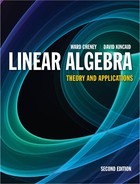APPENDIX B
Complex Arithmetic
“The shortest path between two truths in the real domain passes through the complex domain.
—JACQUES HADAMARD
The different branches of arithmetic—ambition, distraction, uglification, and derision.”
—LEWIS CARROLL in Alice in Wonderland
B.1 Complex Numbers and Arithmetic
Let us outline the rules for complex arithmetic. A complex number z is of the form z = x + iy, where x and y are real numbers and i is defined by the requirement i2 = −1. We call x the real part of this complex number, and y the imaginary part. An imaginary number is iy, where y is a real number. Addition, subtraction, and multiplication are defined by the equations
|
(In both equations, a, b, x, and y are real. Sometimes we forget to emphasize this.) A reciprocal is calculated like this:
|
The absolute value or modulus of the complex number z = x + iy is defined to be ![]() . The conjugate of the same complex number z is defined to be
. The conjugate of the same complex number z is defined to be ![]() . Consequently,
. Consequently, ![]() if and only if z is real. Also, one then verifies quickly that
if and only if z is real. Also, one then verifies quickly that ![]() . Thus, the reciprocal of z as calculated previously is more easily obtained by writing
. Thus, the reciprocal of z as calculated previously is more easily obtained by writing
|
It follows that a quotient of complex numbers w and z can be computed as
|
Other properties are |wz| = |w||z| and ![]() . We can write a complex number z in polar coordinates as
. We can write a complex number z in polar coordinates as
|
with an angle θ and a magnitude |z|. If w = |w| (cos φ + i sin φ), then zw = |z| |w| [cos(θ + φ) + i sin(θ + φ)]. As a special case, when z = w, we obtain
|
In general, we have
|
which is proved by induction. The equation
|
is known as de Moivres’ Theorem.1 The famous equation
|
is called Euler’s Equation. It was discovered by the great mathematician Leonhard Euler in 1748.2
B.2 Fundamental Theorem of Algebra
Now that complex numbers are available, we can state an important historical theorem:
THEOREM 1
Every polynomial of degree one or more has a root in the complex field.
Note that this theorem does not say that every real polynomial has a real root. The simplest examples show that this is not so. Thus, the polynomial x2 + 1 has no real root, even though its coefficients are real.
The preceding theorem is called the Fundamental Theorem of Algebra. It was first conjectured by Girard in 1629. The first proof was by Gauss in 1799. That indicates an astonishing delay in establishing such a crucial result. The history of this theorem is related in detail in the book by Kline [1968].
Once this theorem has been established, it is a simple matter to prove that a polynomial of degree n has a factorization of the following type:
|
In this equation, the roots rj of the polynomial may be complex; they are not necessarily different from each other. If one factor is repeated k times in the factorization, then there will be a term of the form (z − rj)k. We say that rj is a root having multiplicity k.
B.3 Abel–Ruffini Theorem
The following result is considered one of the jewels of mathematics. It was established by Ruffini in 1813 and by Abel [1826]. For more details, see Wells [1986, p. 59] and Pesic [2003].
2 Leonhard Euler made contributions to virtually all branches of mathematics. He wrote 866 articles and books on calculus, planetary motion, the calculus of variations, and mechanics, to name a few topics in which he was the acknowledged master. Euler was a complete genius: His memory was phenomenal and he could recite many poems, including the Aeneid. He could carry out complicated calculations in his head. He spent many years in Russia at the Petersburg Academy, and served there at the request of Catherine the Great.
THEOREM 2 Abel–Ruffini Impossibility Theorem
The roots of some polynomial equations of degree five or higher are incapable of algebraic solutions by a finite number of additions, multiplications, divisions, and root extractions operating on the coefficients.
The second, third, and fourth degree polynomial equations can always be solved by radicals. However, x5 − x + 1 = 0 cannot be solved by radicals (although x5 − x4 − x + 1 = 0 can).
